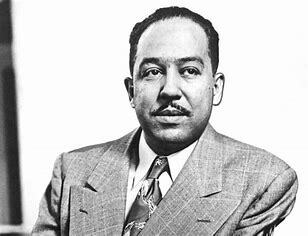Langston Hughes was not just a poet—he was the heartbeat of the Harlem Renaissance. A prolific writer, Hughes gave voice to the joys, struggles, music, and beauty of African American life during a time when Black identity was being redefined. Through poetry, prose, drama, and essays, Hughes built a literary legacy that continues to influence generations. His words didn’t just paint pictures—they sang songs of resilience, hope, pain, and pride. This blog delves into his life, work, and enduring impact on American culture.
Early Life and Influences
James Mercer Langston Hughes was born on February 1, 1902, in Joplin, Missouri. His parents separated when he was young, and Hughes spent much of his childhood in Lawrence, Kansas, raised by his grandmother. It was she who instilled in him a sense of racial pride and a deep appreciation for Black heritage. Hughes later joined his mother in Lincoln, Illinois, and then moved to Cleveland, Ohio, where he attended high school.
During these formative years, Hughes began writing poetry and was deeply influenced by the works of Paul Laurence Dunbar, Carl Sandburg, and Walt Whitman. But it was the rhythms of Black life, the cadence of jazz and blues, and the stories of everyday people that would truly shape his voice.
The Birth of a Literary Star
After high school, Hughes briefly studied at Columbia University, but he felt out of place among the elite white students. Nevertheless, his time in New York exposed him to Harlem, which would become his creative and spiritual home. Before fully settling into his writing career, Hughes traveled extensively—working on ships that took him to Africa and Europe. These travels broadened his perspective and deepened his understanding of global Black identity.
In 1921, Hughes published his first poem, The Negro Speaks of Rivers, in The Crisis, the NAACP’s magazine edited by W.E.B. Du Bois. The poem, rich with historical and spiritual depth, immediately marked Hughes as a fresh and powerful literary voice. It tied the identity of Black Americans to the grandeur and longevity of rivers like the Nile and the Mississippi—a bold, affirming metaphor at a time when Black humanity was still under attack in the United States.
Harlem Renaissance Icon
The 1920s ushered in the Harlem Renaissance, a cultural explosion centered in Harlem, New York. It was a time of renewed pride, artistic innovation, and social critique. Langston Hughes became one of its brightest stars. Unlike many Black intellectuals of the time, Hughes chose to write about the working class—maids, musicians, waiters, and struggling students—not just elite or “respectable” Black life.
In 1926, he published his first book of poems, The Weary Blues, which included famous works like I, Too and the title poem The Weary Blues. These poems mixed traditional poetic forms with jazz and blues rhythms. He wrote not for academic circles, but for the people. He once declared:
“An artist must be free to choose what he does, certainly, but he must also never be afraid to do what he might choose.”
Hughes’s refusal to sanitize or whitewash his depiction of Black life caused friction with some Black intellectuals who wanted art to uplift and project an image of dignity. But Hughes saw beauty and dignity in truth. He believed that all parts of Black life—not just the polished or perfect—deserved to be represented in art.
Themes in His Work
Hughes’s work spanned across multiple genres, and his themes were varied, yet always deeply rooted in the Black experience. Some of the most prevalent themes in his poetry and prose include:
-
Racial Pride and Identity: He constantly affirmed the value of Black culture and heritage. In I, Too, he proclaims, “I, too, sing America,” challenging the notion that Black people were outsiders in their own country.
-
Music and Rhythm: Hughes was known for blending jazz and blues into his poetry, creating a lyrical, improvisational style that mirrored the music of Harlem’s clubs and streets.
-
Social Injustice and Inequality: From police brutality to poverty, Hughes highlighted the systemic issues facing African Americans. His poem Let America Be America Again critiques the failure of the American Dream for marginalized people.
-
Dreams and Hope: A recurring motif in his poetry was the idea of dreams deferred or denied. In Harlem, he asks:
“What happens to a dream deferred?
Does it dry up like a raisin in the sun?...
Or does it explode?”
This iconic line later inspired Lorraine Hansberry’s famous play A Raisin in the Sun.
Beyond Poetry: Plays, Novels, and More
While Hughes is best known as a poet, he was also a successful playwright, novelist, and essayist. His first novel, Not Without Laughter (1930), won the Harmon Gold Medal for Literature. The book explored Black life in a Midwestern town, focusing on family, religion, and race.
Hughes also created the character Jesse B. Semple, or “Simple,” a Harlem everyman who voiced sharp and humorous observations on race, politics, and daily life. These columns were published in the Chicago Defender and later compiled into books.
His plays, such as Mulatto and Troubled Island (the latter co-written with William Grant Still), often dealt with interracial relationships, identity, and oppression. Hughes believed that theater was a vital tool for education and social change.
Political Views and Controversy
Hughes’s politics evolved over time. In the 1930s, during the Great Depression, he became more openly leftist, sympathizing with Marxist ideals and joining radical writers’ groups. He traveled to the Soviet Union and even wrote poetry praising workers’ rights and equality. These political leanings attracted the attention of U.S. government agencies, especially during the Red Scare of the 1950s.
In 1953, Hughes was subpoenaed to testify before Senator Joseph McCarthy’s anti-Communist committee. Though he denied being a Communist, the scrutiny damaged his public reputation temporarily. Still, he never stopped writing and remained committed to social justice throughout his life.
Legacy and Cultural Impact
Langston Hughes died on May 22, 1967, but his legacy is as alive today as it was during the Harlem Renaissance. His poetry is studied in classrooms around the world. His words have been quoted in civil rights speeches, sermons, songs, and political movements. From Martin Luther King Jr. to Maya Angelou and Amanda Gorman, generations of Black writers and thinkers have drawn inspiration from Hughes’s fearless voice.
The Harlem home where he lived for the last 20 years of his life has been preserved as a cultural landmark. Schools, libraries, and awards have been named in his honor. His ashes are interred beneath a cosmogram medallion at the Schomburg Center for Research in Black Culture in Harlem, fittingly engraved with a line from The Negro Speaks of Rivers.
Conclusion
Langston Hughes was more than a poet—he was a griot, a chronicler of a people’s pain, joy, resilience, and dreams. In a time when Black voices were often silenced or distorted, Hughes spoke with clarity and courage. He painted Black life in full color—not just the triumphs, but the wounds and weariness too.
His belief in the beauty of his people, his blending of art with activism, and his refusal to conform make him an eternal beacon in African American and American literature. Through his writing, Hughes reminded us all:
“Hold fast to dreams,
For if dreams die,
Life is a broken-winged bird
That cannot fly.”
Langston Hughes held fast to his dreams—and because of him, so can we.




Share this page with your family and friends.